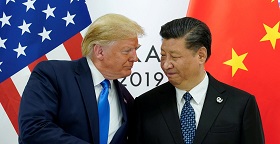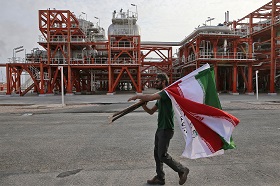In the last few years, China’s energy policy has changed radically owing to both the changed priorities in domestic policy and sharp bifurcations in the international situation. As the growth pace of the national economy slowed down, China’s leadership announced a course of stimulating domestic consumption and rebuilding the economy by expanding the services sector and emphasizing innovations. China’s leaders also formulated a series of priority tasks in reforming the financing, taxation and social sectors. These shifts resulted in a significant slow-down in primary power consumption growth in China. Moreover, environmental pollution in China was recognized as a national problem affecting the quality of life. Economic development plans acknowledge reducing the use of coal and increasing that of “clean” resources (natural gas, nuclear energy, and renewable energy sources) as necessary and pressing tasks. China is firmly set to follow through on its Paris Accord commitments to cut СО2 (carbon dioxide) emissions by 2030. All these changes are set out in China’s 13th five-year-plan for energy development.
The fundamental principles of China’s energy policy remain unshakeable. First, ensuring the security of energy source imports, including imports by sea. In that respect, importing oil from Venezuela is preferable to importing it from the Middle East. Second, it is important to diversify energy sources (also for reasons of energy security). The third principle is creating conditions to ensure low prices on global energy markets. Finally, creating conditions for China to acquire assets in oil and gas companies of foreign countries.
In that connection, the US sanctions against Iran and Venezuela do not cause China serious concern, unlike the US escalating trade war with China itself, where conflicts in energy and related sectors might cause China to adjust at least its tactical decisions. So China remains flexible in its tactics while persevering in its strategy.
In the last few years, China’s energy policy has changed radically owing to both the changed priorities in domestic policy and sharp bifurcations in the international situation. As the growth pace of the national economy slowed down, China’s leadership announced a course of stimulating domestic consumption and of rebuilding the economy by expanding the services sector and emphasizing innovations. China’s leaders also formulated a series of priority tasks in reforming the financing, taxation, and social sectors. These shifts resulted in a significant slow-down in primary power consumption growth in China. Moreover, environmental pollution in China was recognized as a national problem affecting the quality of life. Economic development plans acknowledge reducing the use of coal and increasing use of “clean” resources (natural gas, nuclear energy, and renewable energy sources) as necessary and pressing tasks. China is firmly set to follow through on its Paris Accord commitments to cut СО2 (carbon dioxide) emissions by 2030. All these changes are set out in China’s 13th five-year-plan for energy development.
In the 13th five-year-plan, China will base its energy policy on improving the structure of power supply and demand. China calls this the “Double Alternative”, meaning, first, moving away from coal to natural gas and second, transitioning from fossil fuels to renewable energy sources. The 13th five-year-plan sets the task of ensuring that, over a period of five years, annual growth of primary power consumption does not exceed 3% and the share of coal in the balance of primary sources does not exceed 58% by 2020 (64% in 2015). In order to achieve these goals, the decision was made to increase tariffs on power produced using renewables to 15% (12% in 2015) [1], and the tariff on power produced using natural gas to 10% (5.9% in 2015).
These measures apply primarily to the power industry and to ensuring a stable power supply for the economy and the population. Yet oil and oil-based fuels still play the key role in China’s energy policy since the country’s transport sector is developing and generating a demand for engine fuel and, consequently, for oil. Since China’s own oil production meets no more than 40% of its domestic demand and since mass-scale introduction of alternative engine fuels (gas, biodiesel, hydrogen and electric) takes time and has several natural restrictions, the problem of stable oil imports is a long-term “pain in the neck” for China’s leadership.
With economic development slowing down, with China’s government imposing certain restrictive measures and with alternative engine fuels developing explosively, growth of oil consumption and imports have slowed down. Although oil prices are highly volatile, they have for a long time remained fairly comfortable for China. Today, the main problem for China and for the global oil market is the growing uncertainty stemming from geopolitical tensions, the threat of a spiralling trade war between the US and China, and an array of sanctions the US is actively imposing on several countries. Curiously, these countries include China’s major suppliers of hydrocarbons: Russia, Iran, Venezuela and Libya. All these circumstances create risks for China in endeavouring to meet its development goals.
US–China Trade War
Since, in early May 2019, the US embarked on rigorously implementing its threats in the escalating trade war against China, the global economy found itself embroiled in uncertainty and tensions. Against the backdrop of failed talks, the parties are raising mutual trade tariffs. Such steps exchanged by the two states could develop into a real trade war. The situation is exacerbated by the pressure the US applies by setting a string of deadlines. Nonetheless, experts conclude that the parties are testing each other and that, ultimately, a compromise will be worked out.
It is important to note that China mostly responds, while the Trump Administration spearheads the exacerbation by cranking up its rhetoric. China’s stance can be explained by Beijing trying to hedge economic risks as much as possible in order to implement their announced development plans intended to overcome the difficulties in stabilizing China’s economy and in implementing its policies on the domestic and foreign markets, including the energy sector.
The trade conflict with the US resulted in China demonstrating its independence from American oil and LNG. For three months (between September and November 2018), Chinese companies did not purchase American oil and resumed imports in December 2018, purchasing only insignificant amounts. China quickly found replacements; Iran offered the required quantities of oil at major discounts.
The situation with American LNG was similar. Throughout 2017 and until September 2018, LNG deliveries from the US to China grew rapidly (in eight months of 2018 alone, they increased by 17%, to almost double the amount supplied to Europe). In September 2018, Washington imposed 25% duties on hundreds of billions of dollars-worth of goods from China. In response, China announced 10% duties on American LNG effective 24 September 2018 and stopped importing American LNG.
A major project for supplying American liquefied natural gas to China (the Magnolia LNG project for constructing a terminal in Louisiana) with the participation of Chinese capital also turned out to be at risk. Additionally, Chinese companies are, in theory, interested in Alaska Gasline Development Corp’s project to build LNG infrastructure for Alaska LNG’s liquefied natural gas. The final decision on investing in the project, costing USD 43 billion, is to be made in 2020. Today, the situation surrounding the project is unclear.
The escalation of the direct U.S.–China trade war is thus bringing greater losses to the US than to China, which can use alternative sources given the oil and LNG supply glut on the global market and oil and gas being offered at acceptable or even lower prices. Yet the US is affecting the freedom of choice between such sources by imposing sanctions, in particular, on Iran and Venezuela. Until recently, these countries were important suppliers of oil to China.
US Sanctions against Iran
The international agreement known as the 2015 Joint Comprehensive Plan of Action (JCPOA) lifted international sanctions previously imposed on Iran. China, France, Germany, Russia, the UK, the US, and the EU were parties to the JCPOA. Iran promised to curb its nuclear program in exchange for lifting the economic sanctions. On May 8, 2015, however, US President Donald Trump announced the US’s withdrawal from the agreement.
In November 2018, the US imposed new sanctions on Iran. In response to the continuation of the nuclear program, restrictive measures envisioned a complete stop to oil exports, though Washington made exemptions for eight states, allowing them to purchase Iranian oil during a certain fixed period. These are China, Turkey, South Korea, India, Greece, Italy, Taiwan, and Japan. The exemption was introduced for half a year, until May 2, 2019. Greece, Italy, and Taiwan stopped importing oil from Iran back in November 2018. By May 2019, all the countries covered by the exemption had stopped importing Iranian oil. Until recently, China was the biggest importer of oil from Iran. Iran, in turn, was China’s sixth biggest supplier of crude oil (about 7%). Before May 2019, taking advantage of reduced prices on Iranian oil, China significantly increased purchases from Iran. Between January and March 2019, maritime deliveries of commodities from the Islamic Republic to China grew by 78%. Additionally, Iran–China business ties continued to expand beyond the energy sector. For instance, China launched railway services from Bayannur (northern autonomous district, Inner Mongolia) to Tehran (about 8,000 kilometers).
Sinopec and China National Petroleum Corp invested billions of dollars in Iran’s oil deposits; these companies are interested in recouping their investment by shipping oil from those deposits to China. In addition, China offered Iran a USD 3 billion loan to explore oil deposits further. Given these circumstances, many experts believed that Beijing would continue to purchase oil from Iran despite Washington’s pressure. Yet the latest reports state that, in May 2019, purchases stopped. The last Chinese tanker carrying Iranian oil got stuck somewhere in Southeast Asia and never reached China.
Two qualifications should be made here. First, technically, China can resume oil imports from Iran any time, using them as a response to US pressure or as a bargaining chip in its big game with Washington. Second, Beijing can, even if not without difficulty, replace about 30 million tonnes of Iranian oil with oil from its biggest oil-trading partners, Russia and Saudi Arabia (first and second biggest suppliers of oil to China). Even so, it will be difficult to do this since some China’s oil refineries are geared to processing Iranian oil.
It should be noted that, despite Moscow’s political support for Iran, Russian businesses are not eager to work with Iran bypassing American sanctions. Consequently, in November 2018, wary of US sanctions, Zarubezhneft withdrew from promising projects in Iran.
US sanctions against Venezuela
Today, Venezuela is going through a dire political and economic crisis. Quality of life there is deteriorating, severe measures for distributing goods are introduced, manufacturing is falling, and that includes the energy sector. The military continues to support Nicolás Maduro, while the National Assembly and part of the population support Juan Guaidó as provisional president. The latter has been recognized as Venezuela’s legitimate president by the US and many countries of Europe, Asia, and Latin America.
The US has been imposing sanctions of varying severity on Venezuela’s government and officials for over ten years, and its range is constantly expanding. Sanctions were imposed after the country’s leadership was accused of supporting terrorism, of drug and human trafficking, of anti-democratic actions, human rights violations and corruption. As of today, the US Department of the Treasury has imposed sanctions on 112 individuals, and the Department of State has revoked visas issued to hundreds of individuals. On January 28, 2019, the US Administration announced sanctions on Venezuela’s state-owned oil company Petróleos de Venezuela, S.A. (PDVSA).
As a result, all the assets and funds PDVSA owns in the US are frozen and US citizens are prohibited from dealing with the company. At the same time, the US government allowed individual operations and types of activity related to PDVSA and its subsidiaries that are necessary to complete previously concluded agreements. Transactions with two PDVSA subsidiaries in the US, PDV Holding, Inc. (PDVH), and CITGO Holding, Inc., were initially allowed until July 27, 2019, but, in March 2019, the US Department of the Treasury extended the adaptation period for 18 months. PDVH, CITGO and other US companies were also granted permission to import PDVSA oil until 28 April 2019, though payments to PDVSA should be made into the frozen account in the US. Several American companies working in Venezuela with PDVSA have the right to continue their work until July 27, 2019.
In April 2019, the US Department of the Treasury imposed sanctions on 44 vessels (and six shipping companies) that transport Venezuelan oil, including five companies that transported Venezuelan oil to Cuba. In the meantime, following sanctions imposed on PDVSA, China continuously increased oil imports from Venezuela (in February, imports reached over 2 million tonnes).
It should be noted that Venezuela holds first place among the Latin American countries in the volume of Chinese investment (over 50%). In this, Venezuela is significantly ahead of, for instance, Brazil and Argentina. The country’s oil sector accounts for the principal volume of Chinese investment. In addition to direct investment, China has given Venezuela several loans to be repaid in shipments of oil or in payments from oil sales. In that connection, Beijing is highly interested in continuing to import Venezuelan oil despite Washington’s sanctions. At the same time, China realizes the risks and problems involved in developing Venezuela’s oil sector. Beijing reacted rather calmly to the appearance of the “alternative” President Juan Guaidó and is ready to negotiate with Nicolás Maduro’s successors.
***
China’s energy policy is aligned with the goals set in the country’s government programs. These goals are extremely ambitious and require transitioning to a new energy structure using cutting-edge technologies and approaches to resolving environmental problems that the country has never employed before.
The fundamental principles of China’s energy policy remain unshakeable. First, ensuring the security of energy sources imports, including imports by sea. In that respect, importing oil from Venezuela is preferable to importing it from the Middle East. Second, it is important to diversify energy sources (also for reasons of energy security). The third principle is creating conditions to ensure low prices on global energy markets. Finally, creating conditions for China to acquire assets in the oil and gas companies of foreign countries.
In that connection, the US sanctions against Iran and Venezuela do not cause China serious concern, unlike the US’s escalating trade war with China itself, where conflicts in energy and related sectors might cause China to adjust at least its political decisions. So China remains flexible in its tactics while persevering in its strategy. Just sitting by the proverbial river, waiting...
1. According to Chinese media, the stimulating (“green”) tariff on power from renewables was abolished in June 2019.
https://chinadailyasia.com/








